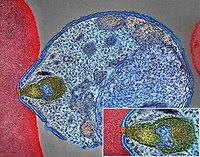
Photo from wikipedia
The malaria parasite Plasmodium falciparum has evolved an unusual genome structure. The majority of the genome is relatively stable, with mutation rates similar to most eukaryotic species. However, some regions… Click to show full abstract
The malaria parasite Plasmodium falciparum has evolved an unusual genome structure. The majority of the genome is relatively stable, with mutation rates similar to most eukaryotic species. However, some regions are very unstable with high recombination rates, driving the generation of new immune evasion-associated var genes. The molecular factors controlling the inconsistent stability of this genome are not known. Here we studied the roles of the two putative RecQ helicases in P. falciparum, PfBLM and PfWRN. When PfWRN was knocked down, recombination rates increased four-fold, generating chromosomal abnormalities, a high rate of chimeric var genes and many microindels, particularly in known ‘fragile sites’. This is the first identification of a gene involved in suppressing recombination and maintaining genome stability in Plasmodium. By contrast, no change in mutation rate appeared when the second RecQ helicase, PfBLM, was mutated. At the transcriptional level, however, both helicases evidently modulate the transcription of large cohorts of genes, with several hundred genes—including a large proportion of vars—showing deregulated expression in each RecQ mutant. Aberrant processing of stalled replication forks is a possible mechanism underlying elevated mutation rates and this was assessed by measuring DNA replication dynamics in the RecQ mutant lines. Replication forks moved slowly and stalled at elevated rates in both mutants, confirming that RecQ helicases are required for efficient DNA replication. Overall, this work identifies the Plasmodium RecQ helicases as major players in DNA replication, antigenic diversification and genome stability in the most lethal human malaria parasite, with important implications for genome evolution in this pathogen.
Journal Title: PLoS Genetics
Year Published: 2018
Link to full text (if available)
Share on Social Media: Sign Up to like & get
recommendations!